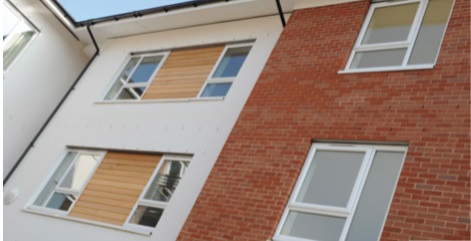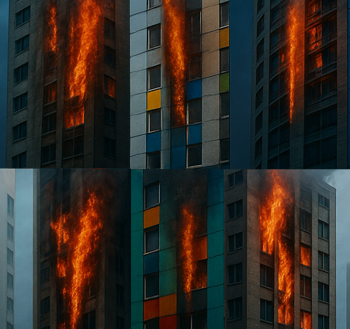Noise - doors and windows
Unwanted and intrusive noise is impacting on more and more lives; especially as pressure to build homes on brownfield sites is remorseless. Chris Coxon, Head of Marketing at Eurocell, considers the issue in the context of doors and windows.
The issue of noise and how to deal with it in new housing developments is becoming a more complex one. Planning policy and the demand for city centre locations means that brownfield sites which were once considered unattractive are now under development.
How loud is too loud?
The World Health Organisation (WHO) guidelines for community noise recommend less than 30 A-weighted decibels (dB(A)) in bedrooms during the night for a sleep of good quality and less than 35 dB(A) in classrooms to allow good teaching and learning conditions.
The WHO guidelines for night noise recommend less than 40 dB(A) of annual average (Lnight) outside of bedrooms to prevent adverse health effects from night noise. (Lnight is the equivalent continuous noise level over the night-time period (23:00 to 07:00).)
Masonry mass is really important in defeating sound. However, as Approved Document E of the Building Regulations 2010 — which devotes significant attention to the detailing of various wall types — acknowledges: completely sealing structures against noise is impossible, especially where one needs to punch through it with doors and windows, so creating a vulnerability to sound in the envelope. And here the Regulation is not helpful, barely considering the issue at all.
Approved Document N, dedicated to glazing, is similarly silent, concerning itself only with safety; while Approved Document L, the Building Regulation most cited in the context of doors and windows, troubles itself only with energy - and not sound - efficiency.
For guidance then, we must look elsewhere: such as in BS EN 12758, Glass in Building — Glazing and Airborne Sound Insulation, and BS 8233 2014 Sound Insulation and Noise Reduction. The latter is a comprehensive document deeply complex in calculation and detail, and is not to be approached lightly or by the generalist; while BS EN 12758 gives values for the sound insulation of windows.
The first thing to consider in respect of doors and windows is fit and quality - an area where modern PVC-U items may be thought to have advantages. Not only are multi-chambered PVC frame profiles inherently sound attenuating, they are also warp-free. This is important as any kind of distortion in the frame can seriously reduce the effectiveness of the seal.
Window reveals should also be well sealed to prevent sound getting into the wall cavity. At a junction with a separating wall, it is desirable to close the external cavity with a flexible closer, such as Rockwool. If the cavity is likely to be filled for purposes of thermal efficiency, then the closer is unnecessary. Some window specifications see the addition of an EDPM strip, fitted to the exterior of the window frame and lapping onto the cladding of the building. Designed to improve weather-tightness, these also provide increased noise attenuation.
It may be also important to consider other aspects of the glazing system. Trickle vents, for instance, are a pathway for noise; acoustic-rated vents are available, although these are a costly addition.
In respect of doors, the mass - as alluded to above in the context of masonry - is important as is, like windows, fit. It is essential that the door forms an airtight seal against its frame when closed, and joints between wall and frame are properly stopped. Thresholds are necessary and even escutcheons for keyholes should be considered in the most extreme circumstances.
Surprisingly perhaps, double-glazing does not necessarily perform significantly ‘better than a single pane of mass equivalent to the thicker pane of the sealed unit, and should be used in a frame with good seals to realise its full insulating potential’ (BS 8233). As the thickness and mass of a pane of glass increase, so does its sound insulation qualities, yet not exponentially and there are obviously practical limits to this.
Laminated glass performance, when formulated with resins that have enhanced sound attenuating properties, is better than single pane - ‘monolithic’ - glasses yet are often most encountered in safety and security applications.
Interestingly, gas filling of insulated double glazing units has no effect on sound insulation and, with some types of gases, may be detrimental in the face of low-resonance noise such as that emanating from traffic and trains.
Again, the width of a cavity in a sealed unit has little effect except in triple-glazed applications; yet much of that improvement may be attributed to the additional mass of the third glass pane.
Despite this, a cleverly designed unit - combined with engineered profiled frame materials, and part of a window properly fitted and sealed - can achieve a decent degree of sound insulation, and in excess of that provided by more traditional alternatives. Such a design would necessarily involve a laminated pane, and varying thicknesses of pane. One should be mindful that different pane thicknesses are associated with different resonances of sound; so should be specified in the context of a noise risk assessment, i.e. what type of sound are you most trying to screen out?
One curious effect is that height has little effect in reducing noise intrusion. This is simply because the higher the building, the more sources of noise it is exposed to and, in high rise or dense urban environments, the reflectivity of hard facades will bounce sound vertically.
Whatever the solution, and it is time the Building Regulations considered sound insulation in the context of sealed units, frame materials and airtightness; with increasing urbanisation, we will have more noise. Not only more noise, but louder, more intrusive and more upsetting. It will continue to grow in scale and severity because of traffic growth, population growth and the use of more mobile and powerful technologies: phones and other audio, for instance.
This article was originally published in AT Autumn 2017.
--CIAT
[edit] Related articles on Designing Buildings
Featured articles and news
Delivering for tenants; National Retrofit Hub
New report offers recommendations to strengthen energy efficiency standards to protect private renters.
Government consultations for the summer of 2025
A year of Labour, past and present consultations on the environment, the built environment, training and tax.
CMA competitiveness probe of major housing developers
100 million affordable housing contributions committed with further consultation published.
Homes England supports Greencore Homes
42 new build affordable sustainable homes in Oxfordshire.
Zero carbon social housing: unlocking brownfield potential
Seven ZEDpod strategies for brownfield housing success.
CIOB report; a blueprint for SDGs and the built environment
Pairing the Sustainable Development Goals with projects.
Types, tests, standards and fires relating to external cladding
Brief descriptions with an extensive list of fires for review.
Latest Build UK Building Safety Regime explainer published
Key elements in one short, now updated document.
UKGBC launch the UK Climate Resilience Roadmap
First guidance of its kind on direct climate impacts for the built environment and how it can adapt.
CLC Health, Safety and Wellbeing Strategy 2025
Launched by the Minister for Industry to look at fatalities on site, improving mental health and other issues.
One of the most impressive Victorian architects. Book review.
Common Assessment Standard now with building safety
New CAS update now includes mandatory building safety questions.
RTPI leader to become new CIOB Chief Executive Officer
Dr Victoria Hills MRTPI, FICE to take over after Caroline Gumble’s departure.
Social and affordable housing, a long term plan for delivery
The “Delivering a Decade of Renewal for Social and Affordable Housing” strategy sets out future path.
A change to adoptive architecture
Effects of global weather warming on architectural detailing, material choice and human interaction.
The proposed publicly owned and backed subsidiary of Homes England, to facilitate new homes.
How big is the problem and what can we do to mitigate the effects?
Overheating guidance and tools for building designers
A number of cool guides to help with the heat.
The UK's Modern Industrial Strategy: A 10 year plan
Previous consultation criticism, current key elements and general support with some persisting reservations.
Building Safety Regulator reforms
New roles, new staff and a new fast track service pave the way for a single construction regulator.



























